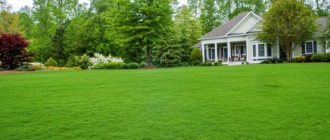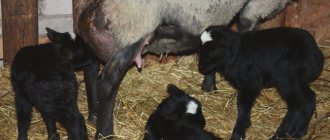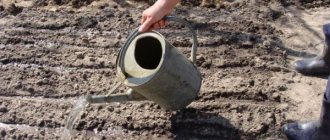General description of culture
Shoot-forming bentgrass (Agrostis stolonifera) is a perennial ornamental grass with a well-developed, branched root system extending to a depth of 10 cm. The leaf blades are narrow, pointed, with a smooth surface and slightly rough edges.
During flowering, the grass throws out loose inflorescences-panicles of light shades. Thin tendrils up to half a meter long extend from bushes with a diameter of 0.3 m. They quickly take root, managing to cover a fairly large area in a season.
Shoot-forming bentgrass is a perennial ornamental grass.
Thanks to vegetative shoots, the culture grows very actively, forming a thick emerald green carpet. The plant feels good in the regions of central Europe, as well as in the south of the continent.
Varieties and types of bentgrass
The unpretentious lawn grass very quickly became popular among European gardeners. Today, botany knows about a dozen varieties of this ornamental grass. Some of them are natural botanical species, others were bred specifically for decorative landscaping. Read on for a detailed description of the most common varieties.
Gigantic
It is a loose tall bush up to 1.5 m high. The leaves are long, narrow, ranging in size from 5 to 20 cm with a width of 3-8 mm. During the growing season, which lasts from late March to early November, panicles 10-25 cm long are formed on flexible vertical stems. Giant bentgrass is quite winter-hardy and resistant to diseases. In its natural environment it is found on the banks of water bodies, meadows or along the roadsides.
Thread-like or thin
This species is characterized by spreading low-leaved bushes 0.5-0.8 m high. The inflorescences are loose, up to 12 cm long and 30-70 mm wide. Thin bentgrass retains its decorative qualities from the beginning of spring until the end of October. It is frost-resistant, tolerates drought well, does not require care, but requires timely removal of the tendrils. Natural habitat is near rivers or lakes, in short grass meadows or depleted fields.
Pros and cons of a lawn
The lawn grass bentgrass has both positive and negative characteristics. Its main advantages include:
- The culture can grow actively in any soil mixture, therefore it is unpretentious to the substrate. Bentgrass is allowed to be used to retain water in the soil in areas where fruit crops grow.
- The culture helps protect the rhizomes of plants if they are still young and weak.
- Another advantage of such a plant is that the dense growth of grass can protect the fruits, which fall from fruit trees after full ripening, from damage.
- The main advantage of such a plant is its attractive appearance. The grass can quickly recover from external influences; it eliminates weeds from the area and quickly grows throughout the garden.
- The grass is resistant to low temperatures.
Like any plant crop, bentgrass is not without its drawbacks. The main ones include the following:
- Experts prohibit walking on the lawn in the first year after sowing on the site.
- If above-zero temperatures prevail in the summer and there is no rain, then it is important to water the lawn regularly and abundantly.
- In winter, the upper part of the lawn dies; it will take about one month for the crop to be restored.
- If a gardener wants to trim the bentgrass lawn on his property, then he only needs to use a lawn mower, since it will not be possible to mow the grass with a trimmer (it has very soft shoots and stems).
Site selection
Bentgrass likes to grow in areas with a good level of light, but it also feels comfortable in diffused light, which forms under fruit crops. Experts prohibit planting lawn grass in completely shaded areas of the garden.
Bent grass has a positive attitude towards almost all types of soil: slurry, saline, loamy, and also with high acidity. But if the crop is planted on garden soils, it will grow very quickly and turn into a real dense and bright flooring.
Preparing the site
Preliminary preparation of a place for sowing a lawn is a rather lengthy and labor-intensive process. It is important to remove all debris from the selected area (this includes household waste, excess branches, leaves, stones). Foreign objects must be carried away, but not buried in the ground, as this can lead to difficulties with the use of special equipment and garden devices.
Features of preparation:
- It is best to eliminate weeds using special products Reglon and Ruandap; only they will help to fully eliminate parasites both from the upper parts of the crop and from its rhizomes.
- It is important to take into account that you need to sow the seeds only after six weeks have passed from the moment the weeds are treated with specialized preparations. It is first important to remove the remains of weeds from the soil.
- The next stage of site preparation will be digging up the site. If a gardener wants to sow lawn grass in the place of a flowerbed or vegetable garden, then it is allowed to dig only with one spade, thereby eliminating large plant clods. If the area has not been processed before, then it is important to use digging in several tiers.
- When digging into the soil mixture, it is best to add manure or compost. If the soil has poor drainage, then an additional layer of soil must be poured into it. It is allowed to use gravel or crushed stone as drainage.
- It is also important to remember about digging up the ground for sowing bentgrass seeds. To carry out this procedure, you need to use a rake.
- After the soil has been loosened, you need to compact it using a roller or with your own efforts (in small steps). It is important to do this so that the soil does not sag after precipitation. Compacted soil has a positive effect on the adaptation of lawn rhizomes and leads to their rapid rooting in the soil.
It is advisable to give the prepared area several months of rest. During this time, the soil will settle well and will be suitable for sowing lawn seeds.
Sowing seeds
Despite the fact that preparing the soil was quite lengthy and troublesome, there should be no problems with the seeds. Sowing them is much easier than plowing the ground. Let's take a closer look at the basic rules for sowing bentgrass.
Deadlines
It is recommended to sow the lawn at the end of April or mid-September. At this time, the bentgrass will bush better and form roots, which will be facilitated by the coolness in the spring and autumn, especially at night.
It is not recommended to sow bentgrass in the hot summer, as the seeds cannot withstand even short-term drying out of the soil and often die.
Seeding rate and depth
It is recommended to sow during periods of calm, windless weather, because the planting material is very fine. It is recommended to plant seeds into the soil to a depth of 1 cm.
After the seeds are embedded in the soil, the area is compacted and watered abundantly.
Considering that bentgrass can grow well and take root with the help of shoots, the consumption per 1 m2 is about 1.5 g of seeds. If you sow more densely, the plant may not have enough necessary nutrition and lighting, and if you save money and plant it rarely, bald spots may form; over time, of course, they will heal, but you will have to wait. In order to sow in the most accurate proportions, it is recommended to use a lawn seeder, setting the sowing rate to a minimum.
Features of planting and care
Garden plants - description, varieties
The main use of the culture is decorating parks, squares and various garden plots. The culture is unpretentious and grows on all types of soil. But there is still an optimal soil for the growth and development of bentgrass - drained and fertile.
Important! It is not recommended to plant the plant in summer, since heat at the initial stage of plant development has an extremely negative effect.
The ornamental crop is drought-resistant, but loves moisture, especially needs water in the first year of life. It will grow in shade, but, of course, not so readily. It is better to plant it in lighted areas.
The most common method of propagation is seed. Seeds are usually sown in spring or autumn.
If you nevertheless decide to sow bentgrass in the summer, then the plant must be provided with regular and high-quality watering.
Visually, bentgrass seeds resemble dust, so before sowing it is recommended to pre-mix them with wet sawdust, keeping the proportions of 1 to 10.
A characteristic feature of the species is the vegetative method of propagation. This method is used when there is a need to expand the boundaries of lawns or create new plantings.
bentgrass seeds
Plant care
Despite the fact that the plant is unpretentious and does not need frequent pruning, it does need regular care. The basic rules of agricultural technology are cosmetic haircuts (usually 3-4 times are enough), the main task is to renew the plant and remove old leaves and shoots.
To prevent rotting of the rhizome, it is necessary to regularly ventilate the turf, lifting it from the ground.
Attention! In bentgrass, over time, the lower layer gradually dies off, which enriches the chemical composition of the soil.
Mulching has a good effect on the rooting of shoots. For mulching, it is recommended to use a mixture of peat, garden soil and sand.
Before the arrival of frost in late autumn, the plant should be mowed low. This process slows down the growth of grass, which greatly facilitates the process of caring for bentgrass in the spring.
Shoot growth is activated when the soil temperature reaches +18-20 degrees. In spring, manipulations such as aeration should be carried out. To stimulate the development of shoots, it is also necessary to add a complex of mineral fertilizers to the soil.
Bentgrass is one of the most common ornamental crops today. It combines a large number of advantages that more than offset the disadvantages. The plant is unpretentious in care, but still requires some manipulations. Even a novice agronomist can give his garden plot an attractive look, because the features of planting bentgrass are quite simple.
Watering
Bentgrass is a plant with a shallow root system that requires moist soil. If the soil is dry, the plant will begin to dry out and lose its decorative appearance. Abundant watering with a sprinkler will help to avoid this; it is especially necessary in dry summers.
Lawn mowing
Important: you can cut bentgrass only with a lawn mower.
This procedure is not frequent, as a rule, no more than three times per season. The fact is that the length of the shoots usually does not exceed 10-12 centimeters. Before the winter season, experts recommend mowing lawn grass at the roots.
Mulching
It is recommended to cover the soil with mulch, namely a mixture of sand, peat and garden soil, in a 1:1:1 ratio in the second year after planting bentgrass. The right time for mulching is the third ten days of April.
Top dressing
In the spring, fertilizing is required with compost, which must be covered in a thin layer, embedding it into the ground using a rake. This fertilizer saturates the soil with nitrogen necessary for vegetation. Subsequent fertilizing with mineral fertilizers is carried out in mid-summer.
Plant in winter
Even with the first snow, bentgrass continues to grow green; it is a frost-resistant plant that does not require additional protection during the winter months. In the spring, after the snow has melted, the lawn looks yellow and limp. But this is not a reason for concern; after a month, the bentgrass will again acquire its decorative appearance.
Bentgrass has many advantages over other lawn plants, it is easy and unpretentious to care for, and will delight you with lush greenery for a long time.
Planting bentgrass
To create a light lawn, plant seeds are sown or cuttings are planted. Bentgrass is sown on previously prepared soil. Its seeds are silky and extremely tiny, similar to dust.
Before sowing, they are mixed with wet sawdust, maintaining a ratio of 1:10. With this planting method, you can clearly see how evenly the seeds are distributed throughout the area. Seeds are not buried or covered with soil.
Bentgrass reproduces well in divisions. When expanding lawns or turfing new areas, adult bushes are used, divided into several parts. The delenki take root well, quickly produce antennae and cover the areas allocated for lawns with a fluffy carpet.
Variety of bentgrass "Kromi"
Of all the varieties of this lawn grass, the most popular worldwide is the bentgrass “Cromie”. The classic low-growing grass forms highly decorative covers on various lawns. Cromi bentgrass is suitable for creating exquisite lawns and golf courses. It can withstand mowing up to 0.5-1 centimeter, which is important for creating moonlight zones.
Thin leaves, soft cover, and luxurious appearance have made this variety a leader in the formation of parterre, dense home, decorative city and garden lawns.
Spreading
You can find thin bentgrass in Eurasia and North Africa. This plant is also often noticed in the southern and western parts of Siberia and the Far East, the Caucasus, the northern part of Central Asia, Scandinavia, Iran, and the Atlantic. Bentgrass grows on almost all types of soil and is quite unpretentious in choosing locations. It can be found both in fields, mostly short grass, and just along the road. It adapts very easily to the terrain and grows in poor soils. It can be seen even on riverine sands, meadows, pebbles and dry soil.
Bentgrass is an aggressive weed
Experts recommend that amateur gardeners take into account that bentgrass can turn into a malicious weed. It is quite difficult to get rid of plants that have fallen into beds or flower beds.
Special borders help prevent bentgrass bushes from entering the vegetable garden and garden arrangements. Decorative structures around the lawn or flower beds turn out to be an impregnable barrier for this lawn grass.
Erecting borders before planting bentgrass helps avoid negative consequences. They will not allow the plant to become an aggressive weed, ready to take over everything around it.
Bentgrass Lawn Care
The lawn for lazy gardeners is formed by bentgrass. Reviews from estate owners, in any case, say so. Indeed, a lawn made from this grass requires minimal maintenance. In the fall, before frost, the grass is mowed low and raked to the side.
This will prevent lawns from losing their decorative appearance in the spring. Last year's grass is practically not combed out of the lawn. Yellowed bushes, through which young greenery is poking through, spoil the appearance of the lawn, leaving not the most pleasant impression of it.
In the spring, after the snow melts, aeration is carried out - the lawns are pierced with a pitchfork over the entire area and watered twice with nutrient solutions prepared from fertilizers for lawn plants.
Viability of lawn grass
Bentgrass has an incredible ability to survive. Her bushes, dried to the point of hay, come back to life. As soon as you dig down the hummocks and provide proper watering, they begin to throw out shoots.
Even more surprising is that crushed bunches of the plant, placed in the ground, sprinkled with a layer of soil, which is regularly moistened, come to life after 30 days and begin to create a fluffy cover, pleasing with emerald greenery. This is such an amazing and resilient grass, bentgrass!
How to propagate bentgrass
Bentgrass is propagated by seeds, which are best sown in the spring, while the soil is moist and it is not yet very hot, or in the fall. Sow to a depth of 0.5-0.8 cm and water regularly. Low night temperatures at this time promote faster root formation. It is important to follow seed sowing standards and not to thicken the crops. Then the young plants begin to bush, form shoots - and now the bentgrass begins to spread on its own
Vegetative method.
If you manage to get even a small piece of bentgrass somewhere, start there. Grass shoots need to be cut into pieces 6-8 cm long (so that there are 2-3 internodes) and scattered evenly onto prepared moist soil, sprinkled with a 1-1.5 cm layer of light soil on top and lightly compacted with a tamper.
When the bentgrass grows, you can take small sections and plant them in the right places. This is how I reproduce it. I do this in the summer, during the rains - then the young divisions quickly take root and begin to grow.
Important!
Bentgrass is a moisture-loving herb, and especially in the first year it needs to be watered abundantly and often - then it will grow quickly and thickly.
In the first year of development of a bentgrass lawn, while the shoots are growing and the roots are strengthening, it is better not to walk on it. But later its shoots become stronger, even become slightly woody, and it acquires stability - you can walk on such a lawn, children can play on it, or sunbathe on it.
Application of low-growing cereal grass
To sod the ground in gardens with fruit and berry bushes and trees, bentgrass is used as a lawn grass. Reviews from gardeners emphasize the fact that bushes retain moisture in the soil and prevent the root system of cultivated plants from freezing.
Thanks to the dense grass stand, young immature trees and shrubs can easily withstand harsh winters. Ripe fruits, falling on the elastic grass cover, do not receive damage, do not become dirty and do not immediately begin to deteriorate.
The soil is sown with bentgrass in the trunk circles of mature trees. In orchards, green cover suppresses the growth of weeds, acts as mulch, and plays the role of an excellent natural fertilizer.
Its graceful bushes look great in the coastal zone of reservoirs. They simultaneously strengthen the coastline and make it decorative. Pots with this plant look original.
To create easy-to-maintain lawns, bentgrass is considered an excellent option. As a lawn grass, it has received wonderful reviews from amateur gardeners and specialists. “Light” lawns are especially relevant for owners of estates with constant employment.
Fluffy green carpets with delicate grass stand are beautiful and useful. It is pleasant to walk on them not only in shoes, but also barefoot. They give gardens and parks a special charm and natural look.











